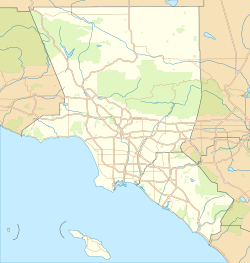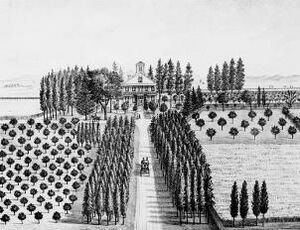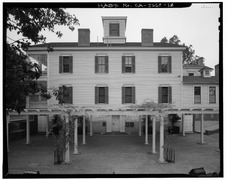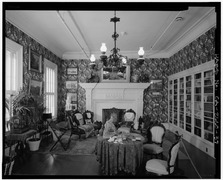Banning House facts for kids
|
Banning House
|
|
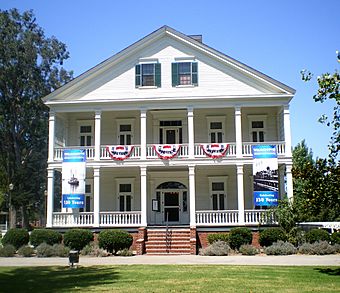
Banning House, August 2008
|
|
| Location | 401 E. M St., Wilmington, Los Angeles, California |
|---|---|
| Built | 1863 |
| Architect | Phineas Banning |
| Architectural style | Greek Revival-Victorian |
| NRHP reference No. | 71000160 |
Quick facts for kids Significant dates |
|
| Added to NRHP | May 6, 1971 |
The Banning House, also known as the General Phineas Banning Residence Museum, is a historic home in the Wilmington area of Los Angeles, California. It was built in 1863 by a man named Phineas Banning. This house is a mix of Greek Revival and Victorian styles.
The Banning family lived in the house until 1925. Since 1927, the City of Los Angeles has owned it. Today, the house, its barn, and gardens are a museum that you can visit. The Banning House property, also called Banning Park, is a special historical site. It is recognized as a city Los Angeles Historic-Cultural Monument, a state California Historical Landmark, and is listed on the National Register of Historic Places.
Contents
History of the Banning House
Phineas Banning himself designed the Banning House. People say it is one of the best examples of Greek Revival architecture in the western United States. The house originally had 30 rooms. Some rooms have been combined, so now it has 24 rooms.
To build the house, Banning got help from many skilled workers. These included shipwrights (people who build ships), blacksmiths, carpenters, and artists. These workers were often employed on clipper ships that visited the Wilmington harbor. Banning was known for hosting big parties for ship captains. He encouraged them to stay in port and fix their ships. He would tell them to seal leaks with tar from the La Brea Tar Pits. It is said that Banning kept giving this warning for about three years until his mansion was finished in 1864.
A Grand Home for its Time
The Banning House was very different from the traditional adobe homes common in Southern California back then. It quickly became a very impressive place. While Banning lived there, the house was famous for its parties. Banning called these parties "regales." Important guests attended, including United States senators, governors, and foreign leaders. Ship captains, Army officers, and business leaders also visited.
Many people believed that "no home in all California represents the horse and carriage era more fully than the Banning Mansion." This was because Phineas Banning entertained so many important people there for decades. The house was also reportedly the site of the first yachting party on the West Coast.
Phineas Banning's Life
Phineas Banning arrived in Los Angeles in 1851. He built very successful transportation businesses. These included ships, railroads, and stagecoach lines. His routes ran from Wilmington to Los Angeles, San Bernardino, and Fort Yuma.
In 1858, Banning founded the town of Wilmington. He named it after his hometown of Wilmington, Delaware. He also built the first railroad in Los Angeles in 1869. This was the Los Angeles and San Pedro Railroad. Banning also designed and promoted the first breakwater at the Los Angeles harbor. Because of all his work, he is known as the "Father of the Port of Los Angeles."
Banning loved to walk up the stairs of his house to the fourth-floor cupola. From there, he would watch ships arriving with their goods. He was also elected to the California legislature in 1867 and 1869. Banning lived in the house for over 20 years until he passed away in 1885.
The Banning House as a Museum
After Phineas Banning died, his son, Hancock Banning, lived in the house until 1894. The Banning family continued to live there until 1925. In 1927, the City of Los Angeles bought the house and its grounds. They wanted to create a city park for the people of Wilmington.
In 1934, the city decided to restore the house. The Banning family generously donated many of the original furniture pieces and equipment. Movie studios, like Twentieth-Century Fox and Warner Brothers, even helped. They gave wallpapers that matched the Civil War era when the house was built.
The house was officially dedicated in 1936. Important people like Governor Frank Merriam and Mayor Frank L. Shaw attended the ceremony. It opened to the public in 1938. However, it closed in 1941 when World War II began. The museum did not reopen until 1952.
What to See at the Museum
Today, the house operates as the General Phineas Banning Residence Museum. When you visit, you can see the house and its original furnishings. There is also a gallery in the basement. It has photographs that show the history of the port, the Banning family, and Wilmington.
The museum also has a large collection of 19th-century stagecoaches. These are displayed in the barn. There is also a one-room schoolhouse next to the main house. The gardens are beautiful, with eucalyptus trees. These trees are believed to be the first planted in California. You can also see large wisteria vines that were planted in the late 1800s.
The museum offers tours led by guides. They are open Tuesday through Thursday afternoons and Saturday through Sunday afternoons. A small donation is requested for visitors aged 12 and older.
Special Historic Status
Banning Park, which includes the Banning House, barn, and gardens, was named a California Historical Landmarks in 1935. Later, in October 1963, the house became one of the first sites to be named a Los Angeles Historic-Cultural Monument (HCM #25). It was also the sixth site in Los Angeles to be listed on the National Register of Historic Places in May 1971.
A special marker at the site, California Historical Landmark NO. 147, explains:
- NO. 147 BANNING PARK - General Phineas Banning, a State Senator and a leader in developing transportation in Southern California, built this house in the 1850s. He did this soon after he founded the town of Wilmington. He and his family lived here until he passed away in 1885. In 1927, the property was given to the city.
Images for kids
More to Explore
- List of Registered Historic Places in Los Angeles
- List of Los Angeles Historic-Cultural Monuments in the Harbor area
- Drum Barracks – Civil War barracks built on land donated by Banning, located down the street from Banning House


